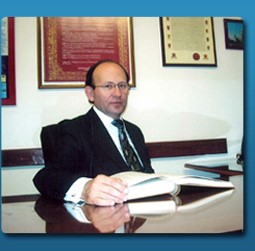Ecclesiastical Law I (Erasmus)
Kyriazopoulos Kyriakos
Τhe system of relations between church and state in Greece and in the member states of the European Union. Legal aspects of the individual right to religious freedom as envisaged enshrined in Greece and in the European Union. Organization, legal personality and administration of religions.
ΛιγότεραΤhe system of relations between church and state in Greece and in the member states of the European Union. Legal aspects of the individual right to religious freedom as envisaged enshrined in Greece and in the European Union. Organization, legal personality and administration of religions.
Τhe system of relations between church and state in Greece and in the member states of the European Union. Legal aspects of the individual right to religious freedom as envisaged enshrined in Greece and in the European Union. Organization, legal personality and administration of religions.
Περίγραμμα

Ομάδα στόχος
- Erasmus students of Law School.
Διδάσκοντες

Kyriakos Kyriazopoulos, Assistant Professor
CV:
http://qa.auth.gr/el/cv/kyrkyr
http://www.law.auth.gr/el/staff-hist-philosophy-kyriazopoulos
http://www.law.auth.gr/en/staff-hist-philosophy-kyriazopoulos
Content development partner: Marianthi Diamantopoulou
Videography - Video editing: Costis Oikonomides
Περιεχόμενο μαθήματος
- The scientific object of Ecclesiastical Law: religious freedom – religious human rights (individual - collective dimension) – constitutional and legal relations between State and Church.
- Sources of Ecclesiastical Law of the Orthodox Church and of minority faiths.
- Interpretative methods of Ecclesiastical Law.
- Restrictions on religious human rights.
- Historical and modern systems of State and Church relations in Europe.
- Temporal relationships of State and Religions in Greece.
- The five orthodox ecclesiastical territories in Greece (Autocephalous Church of Greece, Dioceses of Northern Greece, Church of Crete, Patriarchal Dioceses of the Dodecanese, Mount Athos).
- Acquisition and loss of membership of the Orthodox Church.
- Discrimination of members of the Orthodox Church (clergy, laity, monks).
- Particular legal treatment of clerics and monks.
- Religious communities and minorities.
- The law of religious minorities with legal personality under private law.
Μαθησιακοί στόχοι
- Understanding of: (i) the system of relations between church and state in Greece and in the member states of the European Union, (ii) the legal aspects of the individual right to religious freedom as envisaged enshrined in Greece and in the European Union, as well as (iii) the organization, legal personality and administration of religions.
- Students are expected to improve their general competences, notably to: Apply knowledge in practice. Retrieve, analyze and synthesize data and information, with the use of necessary technologies. Work in an interdisciplinary environment. Generate new research ideas. Appreciate diversity and multiculturalism. Demonstrate social, professional and ethical commitment and sensitivity to gender issues. Advance free, creative and causative thinking.
Προτεινόμενα συγγράμματα
- G. Robbers, State and Church in the European Union, Baden-Baden, 2005.
Προαπαιτούμενα
Βιβλιογραφία
- Robbers, State and Church in the European Union, Baden-Baden, 2005.
- Ferrari & C. Durham (ed.), Law and Religion in Post-Communist Europe, Peeters Publishers, 2003.
Online readings:
- International Covenant on Civil and Political Rights (1966)
- Declaration on the elimination of all forms of intolerance and of discrimination based on religion or belief (1981)
- Universal declaration of human rights (1984)
- General Comment No.22 on the Article 18 of the ICCPR (1994)
- European Convention on Human Rights
- Case of Metropolitan Church of Bessarabia and others v. Moldova (2001)
- Case of Hasan and Chaush v. Bulgaria (2000)
- Supreme Holy Council of the Muslim Community v. Bulgaria (2004)
- Case of Kokkinakis v. Greece (1993)
- Erasmus students of Law School.

Kyriakos Kyriazopoulos, Assistant Professor
CV:
http://qa.auth.gr/el/cv/kyrkyr
http://www.law.auth.gr/el/staff-hist-philosophy-kyriazopoulos
http://www.law.auth.gr/en/staff-hist-philosophy-kyriazopoulos
Content development partner: Marianthi Diamantopoulou
Videography - Video editing: Costis Oikonomides
- The scientific object of Ecclesiastical Law: religious freedom – religious human rights (individual - collective dimension) – constitutional and legal relations between State and Church.
- Sources of Ecclesiastical Law of the Orthodox Church and of minority faiths.
- Interpretative methods of Ecclesiastical Law.
- Restrictions on religious human rights.
- Historical and modern systems of State and Church relations in Europe.
- Temporal relationships of State and Religions in Greece.
- The five orthodox ecclesiastical territories in Greece (Autocephalous Church of Greece, Dioceses of Northern Greece, Church of Crete, Patriarchal Dioceses of the Dodecanese, Mount Athos).
- Acquisition and loss of membership of the Orthodox Church.
- Discrimination of members of the Orthodox Church (clergy, laity, monks).
- Particular legal treatment of clerics and monks.
- Religious communities and minorities.
- The law of religious minorities with legal personality under private law.
- Understanding of: (i) the system of relations between church and state in Greece and in the member states of the European Union, (ii) the legal aspects of the individual right to religious freedom as envisaged enshrined in Greece and in the European Union, as well as (iii) the organization, legal personality and administration of religions.
- Students are expected to improve their general competences, notably to: Apply knowledge in practice. Retrieve, analyze and synthesize data and information, with the use of necessary technologies. Work in an interdisciplinary environment. Generate new research ideas. Appreciate diversity and multiculturalism. Demonstrate social, professional and ethical commitment and sensitivity to gender issues. Advance free, creative and causative thinking.
- G. Robbers, State and Church in the European Union, Baden-Baden, 2005.
- Robbers, State and Church in the European Union, Baden-Baden, 2005.
- Ferrari & C. Durham (ed.), Law and Religion in Post-Communist Europe, Peeters Publishers, 2003.
Online readings:
- International Covenant on Civil and Political Rights (1966)
- Declaration on the elimination of all forms of intolerance and of discrimination based on religion or belief (1981)
- Universal declaration of human rights (1984)
- General Comment No.22 on the Article 18 of the ICCPR (1994)
- European Convention on Human Rights
- Case of Metropolitan Church of Bessarabia and others v. Moldova (2001)
- Case of Hasan and Chaush v. Bulgaria (2000)
- Supreme Holy Council of the Muslim Community v. Bulgaria (2004)
- Case of Kokkinakis v. Greece (1993)
Object and pillars of Ecclesiastical Law – First pillar of Ecclesiastical Law – Second pillar of Ecclesiastical Law – Third pillar of Ecclesiastical Law.
Analysis of the General Comment No.22 – Article 18 paragraph 1 – Article 18 paragraph 2 – Legal meaning of the terms “religion” and “belief” – Human rights v. State privileges – General Comment No.22 paragraph 2 – General Comment No.22 paragraph 3.
General Comment No.22 paragraph 4 – The meaning of the term “worship” – The meaning of the term “observance” – The meaning of the terms “practice” and “teaching” – General Comment No.22 paragraph 5 – General Comment No.22 paragraph 6 – General Comment No.22 paragraph 8 – General Comment No.22 paragraph 9.
Church and state relations in modern Europe (part A) – System of separation – Systems of institutional unity – Church state system – Internal, external and mixed affairs – System of state church – Not state churches/religious communities – Examples of state systems.
Church and state relations in modern Europe (part B) – Institutional unity and separation – Denmark’s state church system – State church v. free church – Systems of institutional separation – Subsystem of Catholic established church – Subsystem of special recognition – Church of Bessarabia.
Church and state relations in modern Europe (part C) – Subsystems of multi-denominational state – Principles – Registered v. unregistered religious organizations – Multi-tire structures of legal regimes.
Church and state relations in modern Europe (part D) – Subsystems of multi-denominational state – Italy’s pyramid – The system of “Laïcité” - European countries with predominantly Orthodox majority (part A).
European countries with predominantly Orthodox majority (part B) – The principle of institutional separation – The principle of state-church cooperation – Special recognition – Prevailing religion (Greece).
European countries with predominantly Orthodox majority (part C) – Special recognition – The right to acquire legal personality.
European countries with predominantly Orthodox majority (part D) – The right to acquire legal personality – Religious discriminations – Principles – Traditional or historic denominations – Regulation of legal personality.
European countries with predominantly Orthodox majority (part E) – Principles – Historical analysis – Related case law – Prohibition of the freedom of disseminating religion denomination – The Russian Federation specific law – Indirect prohibition.
Indirect prohibition – Analysis and interpretation of an academic article – Bulgaria’s legal sources – Principles and fundamental values – Bulgaria’s traditional religion – Course overview – Final remarks.
Ανοικτό Ακαδ. Μάθημα

Αρ. Επισκέψεων : 2902
Αρ. Προβολών : 28526
